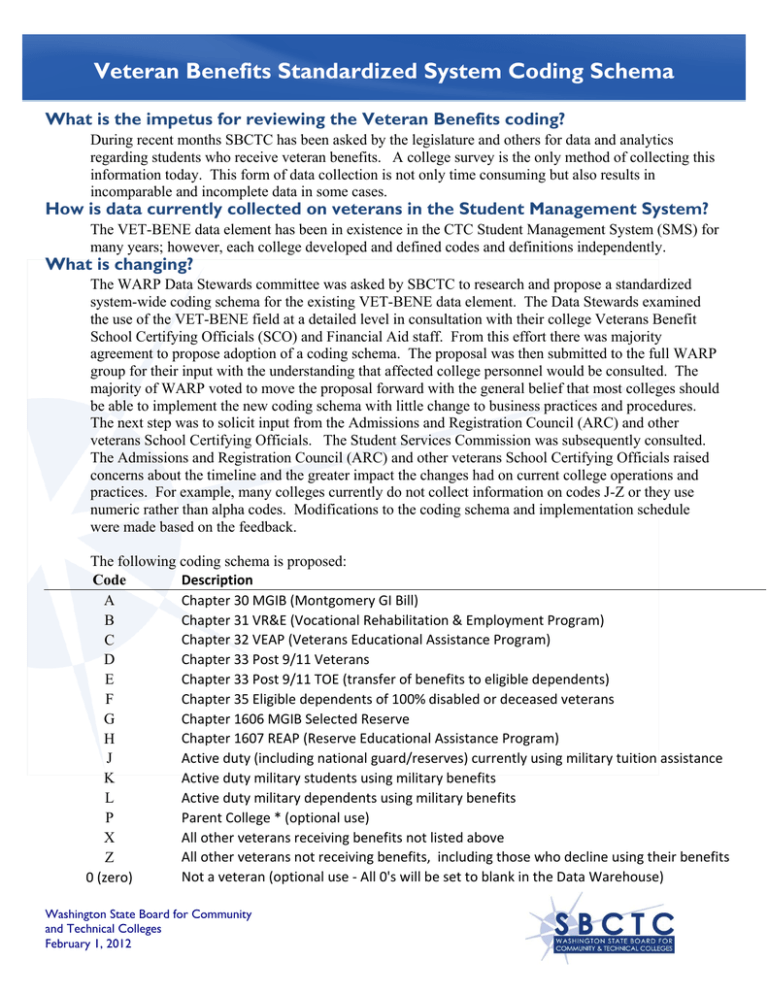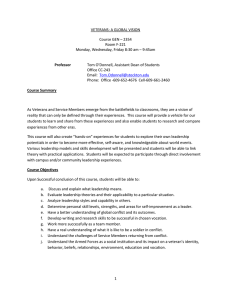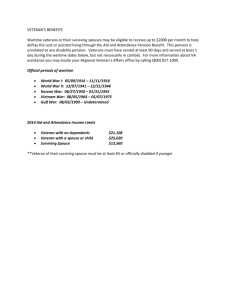Veteran Benefits Standardized System Coding Schema
advertisement

Veteran Benefits Standardized System Coding Schema What is the impetus for reviewing the Veteran Benefits coding? During recent months SBCTC has been asked by the legislature and others for data and analytics regarding students who receive veteran benefits. A college survey is the only method of collecting this information today. This form of data collection is not only time consuming but also results in incomparable and incomplete data in some cases. How is data currently collected on veterans in the Student Management System? The VET-BENE data element has been in existence in the CTC Student Management System (SMS) for many years; however, each college developed and defined codes and definitions independently. What is changing? The WARP Data Stewards committee was asked by SBCTC to research and propose a standardized system-wide coding schema for the existing VET-BENE data element. The Data Stewards examined the use of the VET-BENE field at a detailed level in consultation with their college Veterans Benefit School Certifying Officials (SCO) and Financial Aid staff. From this effort there was majority agreement to propose adoption of a coding schema. The proposal was then submitted to the full WARP group for their input with the understanding that affected college personnel would be consulted. The majority of WARP voted to move the proposal forward with the general belief that most colleges should be able to implement the new coding schema with little change to business practices and procedures. The next step was to solicit input from the Admissions and Registration Council (ARC) and other veterans School Certifying Officials. The Student Services Commission was subsequently consulted. The Admissions and Registration Council (ARC) and other veterans School Certifying Officials raised concerns about the timeline and the greater impact the changes had on current college operations and practices. For example, many colleges currently do not collect information on codes J-Z or they use numeric rather than alpha codes. Modifications to the coding schema and implementation schedule were made based on the feedback. The following coding schema is proposed: Description Code Chapter 30 MGIB (Montgomery GI Bill) A Chapter 31 VR&E (Vocational Rehabilitation & Employment Program) B Chapter 32 VEAP (Veterans Educational Assistance Program) C Chapter 33 Post 9/11 Veterans D Chapter 33 Post 9/11 TOE (transfer of benefits to eligible dependents) E Chapter 35 Eligible dependents of 100% disabled or deceased veterans F Chapter 1606 MGIB Selected Reserve G Chapter 1607 REAP (Reserve Educational Assistance Program) H Active duty (including national guard/reserves) currently using military tuition assistance J Active duty military students using military benefits K Active duty military dependents using military benefits L Parent College * (optional use) P All other veterans receiving benefits not listed above X All other veterans not receiving benefits, including those who decline using their benefits Z Not a veteran (optional use - All 0's will be set to blank in the Data Warehouse) 0 (zero) Washington State Board for Community and Technical Colleges February 1, 2012 * What is the purpose of the P code and how is it used? The “P” code is used on the student’s biographical record (screen SM2001 or SM4002) at the parent college as a place holder during a time when the student is not enrolled at the parent college but is enrolled at a secondary/guest college. The parent college uses this code to indicate that an agreement is in place for the student's transfer-in classes to meet the parent college’s local degree requirements. The chapter detail will be recorded at the secondary/guest college as this is where the student is taking classes. However, in some cases the student takes classes at both the parent and secondary/guest colleges and can be certified to receive benefits at both. In these cases each college would use the appropriate chapter code. The “P” code is not intended to be used on a quarterly enrollment record. The appropriate chapter code should be used for each quarter the student is enrolled. Use of the “P” code is optional. What is the timeline for implementation of this new coding? The 2011-12 academic year is a transition year. SBCTC will not use the data collected during this year for official reporting. Recognition is given that many veteran students have already registered for summer and fall quarters; thus requiring colleges to recode those students will impact staff workload. Therefore, colleges are asked to begin updating and coding their veteran students using the new coding schema as students enroll for winter quarter. Coding summer and fall 2011 enrollments is optional. SBCTC will provide coding reports to the colleges after fall 2011, winter 2012 and spring quarter 2012 to assist in identifying any problems or students missed during the coding process. SCOs are asked to provide feedback to SBCTC throughout this process. Full implementation of the new coding schema will be effective for the 2012-13 academic year. How will the new codes be applied? Steps Step 1 Step 2 Step 3 Step 4 Step 5 Step 6 Step 7 Step 8 Description Time Frame SBCTC tasks WARP Data Stewards with researching and creating a standardized system-wide coding schema for the existing VET-BENE data element. Data Stewards Committee votes on the proposed structure. Gain approval from WARP to move forward Ask for comments and feedback from Registrars and SCO's Gain final approval from Student Services Commission Distribute the final coding schema and ask colleges to update their TBL4 VET-BENE table. Most colleges will need to add the new codes, but a few will need to update the definition if they have already defined the code for previous use. Colleges update and code the VET-BENE field. SBCTC sends quarterly reports to the colleges providing counts by categories and flags for invalid codes. Frequent communication and invalid code reporting will help to remind the colleges to complete their coding and assist them in correcting any problems. Veteran Benefits Standardized System Coding Schema February 1, 2012 2 Jan. 2011 April 2011 May 2011 June 2011 July 2011 August thru the start of Winter Quarter Enrollment 2011 No later than Winter Quarter 2012 registration January 2012 thru June 2012 Washington State Board for Community and Technical Colleges Task 1 – Document Existing Codes and Descriptions Document the existing VET-BENE codes and descriptions that are currently being used. This step is necessary to retain the historical meaning of the codes. It is not the intention of this process to modify student records prior to the 2011-12 academic year. However, if this information is needed, the definitions of codes used previously will need to be applied. Task 2 – Crosswalk existing codes to new codes and/or flag new categories not previously used by your college Using your existing list of codes, determine if there is a replacement value for an existing category with the goal of creating a crosswalk from old codes to new codes. For example, if your college currently uses a code of “1” for Chapter 31, you would crosswalk this value to a “B” which is the new system code for Chapter 31. This information will be used in Step 4 to alert you that you will need to modify any students currently coded with “1” to a value of “B”. Using your existing list of codes, determine if there are any new categories that have not been collected by your college in the past. For example, if your college has not collected information on active duty, you will need to flag codes “J”,”K” and “L” as new codes. This step may require you to modify your registration data elements to align the veteran benefit options available for students to select. Task 3 – Update TBL4 VET-BENE table using screen SM5008 The first step to implementing the new coding schema is to enter the new valid values into TBL4 using screen SM5008. This process will need to be done by each college individually as there is no current consistency that allows for a system-wide update. Modify the description of any codes that already exist in screen SM5008. Make sure to document the existing definition prior to updating it to retain the historical meaning of the code. and/or Add any new code(s) with the description to screen SM5008. and Do not delete any codes from the table. Removing codes from the table that have been used previously will create an error if an edit is needed on the student’s record at a later date. You may want to change the description of codes that have been replaced by the new coding schema to reflect the change. For example, if your college used “1” for Chapter 31 in the past, you could change the description for this code to “replaced by B”. Veteran Benefits Standardized System Coding Schema February 1, 2012 3 Washington State Board for Community and Technical Colleges Task 4 – Determine which students need to be recoded Only students enrolled during the 2011-12 academic year should be updated to the new codes. Historical data should not be recoded. This step will require you to determine if your college will use the “0”(zero) code for students who are not veterans. This is an optional code. The use of the “0” code allows you to identify if a student’s veteran status has or has not been certified. All “0” codes will be converted to a blank in the SBCTC Data Warehouse. This step may require you to resurvey students to associate them to the appropriate chapter. Students may be eligible to receive benefits from more than one chapter; however they may only draw benefits from one chapter per quarter. Code the student to the chapter they are receiving the benefits from during the quarter. Task 5 – Update the student records Update the VET-BENE code on Screen SM700A to modify the quarterly enrollment record. You may choose to update the student’s biographical record on screen SM2001 or SM4002. Doing so will populate the student’s quarterly enrollment record in future quarters. Veteran Benefits Standardized System Coding Schema February 1, 2012 4 Washington State Board for Community and Technical Colleges Frequently Asked Questions Question: How do you code veterans who have more than one funding source? For example, we have veterans under some of the chapters and they also receive tuition assistance (code J). We are assuming code J will be used for JUST those with tuition assistance and everyone else as indicated. Would that be correct? Answer: Code the student to the appropriate federal chapter first. It is anticipated that this data element will be used for college Veteran’s Affairs reporting and therefore if a student is receiving federal funding through the VA, this information should be captured before tuition assistance. Question: We have a student on the Military Spouse Career Advancement Account (CAA) program. She is the spouse of a veteran. X indicates “all other veterans receiving benefits not listed above, but she isn’t a veteran. Should we still code with an “X”? Answer: No, only veterans should be coded as "X". The CAA spouse should be coded as L, dependent or spouse using military benefits. Question: We want to know if we should code veterans who are receiving the veteran’s waivers as an X? We are thinking of the older Vets who do not have any benefits but quality for the veteran’s waiver. Answer: Yes, use code "X" for veteran’s receiving benefits other than the federal chapters listed. Question: We are trying to figure out how these changes affect our processing of admissions applications and Vet coding (two separate offices). Our Veteran’s office in the past has only coded a student with a Vet-Bene code with documentation. Is it expected that these codes only be applied with the same requirement? Answer: Yes, It is expected that these codes will be applied with the same requirements that your college has used in the past. Question: Do you expect “Z” to be applied to anyone that answers yes to the question on the admissions application question of “Are you a veteran?” (Something we have never coded in the system before) and then they would later be changed to the appropriate A-J when documentation is presented? Answer: No, you do not need to link the Z code to the admissions question. Use this code for veteran's who have been certified but are not receiving benefits. Question: Answer: Should the spouse or dependent of a veteran be coded as "Z" if not receiving benefits? No, only veterans should be coded as Z. Question: Does the new coding now require ALL military personnel to provide evidence of WA residency for tuition purposes? Will there now be an audit of these records? If so, what will be the criteria? Veteran Benefits Standardized System Coding Schema February 1, 2012 5 Washington State Board for Community and Technical Colleges Answer: The evidence that is required for residency does not change with the new coding schema. There will be no audit from SBCTC of these records. Frequently Asked Questions Continued Question: The admissions office has been posting an unusual action code “V$” for students who indicated they are a Veteran. Is SBCTC still interested in the V$ code being used? Answer: Yes, the question on the admissions form that posts the “V$” Unusual Action Code was legislatively mandated for the purposes of outreach to veterans and is self-reported by the student. The Vet-Bene field captures information on students who have been verified to be a veteran. Question: Will codes K (active duty military) and L (active duty dependents) be moved from the online admissions application to the SM2001 Admissions screen when we pull in all other student information? Answer: No, there is no technical correlation between the online admissions application and the VETBENE field. Question: For K and L codes, are we to be using these codes for the FPS 09 eligible students? Answer: Yes, FPS 09 eligible students would be coded as K or L. Veteran Benefits Standardized System Coding Schema February 1, 2012 6 Washington State Board for Community and Technical Colleges


